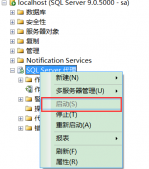SQL Server 2005开始,我们可以直接通过CTE来支持递归查询,CTE即公用表表达式
百度百科
公用表表达式(CTE),是一个在查询中定义的临时命名结果集将在from子句中使用它。每个CTE仅被定义一次(但在其作用域内可以被引用任意次),并且在该查询生存期间将一直生存。可以使用CTE来执行递归操作。创建的语法是:
|
1
2
3
4
5
|
with <name of you cte>(<column names>)as(<actual query>)select * from <name of your cte> |
1、生成数据
|
1
2
3
4
5
6
7
8
9
10
11
12
13
14
15
16
17
18
19
20
21
22
23
24
25
26
27
28
29
30
31
32
33
34
35
36
37
38
39
40
41
42
43
44
45
46
47
48
49
50
51
52
53
54
55
56
57
58
59
60
61
62
|
--菜单目录结构表 create table tb_menu( id int not null, --主键id title varchar(50), --标题 parent int --parent id ); --父菜单 insert into tb_menu(id, title, parent) values(1, '父菜单1',null); insert into tb_menu(id, title, parent) values(2, '父菜单2',null); insert into tb_menu(id, title, parent) values(3, '父菜单3',null); insert into tb_menu(id, title, parent) values(4, '父菜单4',null); insert into tb_menu(id, title, parent) values(5, '父菜单5',null); --一级菜单 insert into tb_menu(id, title, parent) values(6, '一级菜单6',1); insert into tb_menu(id, title, parent) values(7, '一级菜单7',1); insert into tb_menu(id, title, parent) values(8, '一级菜单8',1); insert into tb_menu(id, title, parent) values(9, '一级菜单9',2); insert into tb_menu(id, title, parent) values(10, '一级菜单10',2); insert into tb_menu(id, title, parent) values(11, '一级菜单11',2); insert into tb_menu(id, title, parent) values(12, '一级菜单12',3); insert into tb_menu(id, title, parent) values(13, '一级菜单13',3); insert into tb_menu(id, title, parent) values(14, '一级菜单14',3); insert into tb_menu(id, title, parent) values(15, '一级菜单15',4); insert into tb_menu(id, title, parent) values(16, '一级菜单16',4); insert into tb_menu(id, title, parent) values(17, '一级菜单17',4); insert into tb_menu(id, title, parent) values(18, '一级菜单18',5); insert into tb_menu(id, title, parent) values(19, '一级菜单19',5); insert into tb_menu(id, title, parent) values(20, '一级菜单20',5); --二级菜单 insert into tb_menu(id, title, parent) values(21, '二级菜单21',6); insert into tb_menu(id, title, parent) values(22, '二级菜单22',6); insert into tb_menu(id, title, parent) values(23, '二级菜单23',7); insert into tb_menu(id, title, parent) values(24, '二级菜单24',7); insert into tb_menu(id, title, parent) values(25, '二级菜单25',8); insert into tb_menu(id, title, parent) values(26, '二级菜单26',9); insert into tb_menu(id, title, parent) values(27, '二级菜单27',10); insert into tb_menu(id, title, parent) values(28, '二级菜单28',11); insert into tb_menu(id, title, parent) values(29, '二级菜单29',12); insert into tb_menu(id, title, parent) values(30, '二级菜单30',13); insert into tb_menu(id, title, parent) values(31, '二级菜单31',14); insert into tb_menu(id, title, parent) values(32, '二级菜单32',15); insert into tb_menu(id, title, parent) values(33, '二级菜单33',16); insert into tb_menu(id, title, parent) values(34, '二级菜单34',17); insert into tb_menu(id, title, parent) values(35, '二级菜单35',18); insert into tb_menu(id, title, parent) values(36, '二级菜单36',19); insert into tb_menu(id, title, parent) values(37, '二级菜单37',20); --三级菜单 insert into tb_menu(id, title, parent) values(38, '三级菜单38',21); insert into tb_menu(id, title, parent) values(39, '三级菜单39',22); insert into tb_menu(id, title, parent) values(40, '三级菜单40',23); insert into tb_menu(id, title, parent) values(41, '三级菜单41',24); insert into tb_menu(id, title, parent) values(42, '三级菜单42',25); insert into tb_menu(id, title, parent) values(43, '三级菜单43',26); insert into tb_menu(id, title, parent) values(44, '三级菜单44',27); insert into tb_menu(id, title, parent) values(45, '三级菜单45',28); insert into tb_menu(id, title, parent) values(46, '三级菜单46',28); insert into tb_menu(id, title, parent) values(47, '三级菜单47',29); insert into tb_menu(id, title, parent) values(48, '三级菜单48',30); insert into tb_menu(id, title, parent) values(49, '三级菜单49',31); insert into tb_menu(id, title, parent) values(50, '三级菜单50',31); commit; |
2.查找所有上级节点
|
1
2
3
4
5
6
7
8
9
10
11
12
13
14
15
16
17
18
19
20
21
22
23
24
25
26
27
28
29
30
31
32
33
|
--查询树状结构某节点(44)的上级所有根节点 with cte_parent(id,title,parent) as ( --起始条件 select id,title,parent from tb_menu where id = 44 --列出子节点查询条件 union all --递归条件 select a.id,a.title,a.parent from tb_menu a inner join cte_parent b --执行递归,这里就要理解下了 on a.id=b.parent ) select * from cte_parent; |
3.查找下级节点带level
|
1
2
3
4
5
6
7
8
9
10
11
12
13
14
15
16
17
18
19
20
21
22
23
24
25
26
27
28
29
30
31
32
33
|
--查询树状结构某节点下的所有子节点( with cte_child(id,title,parent,level) as ( --起始条件 select id,title,parent,0 as level from tb_menu where id = 6--列出父节点查询条件 union all --递归条件 select a.id,a.title,a.parent,b.level+1 from tb_menu a inner join cte_child b on ( a.parent=b.id) ) select * from cte_child; |
以上这篇sqlserver实现树形结构递归查询(无限极分类)的方法就是小编分享给大家的全部内容了,希望能给大家一个参考,也希望大家多多支持服务器之家。














